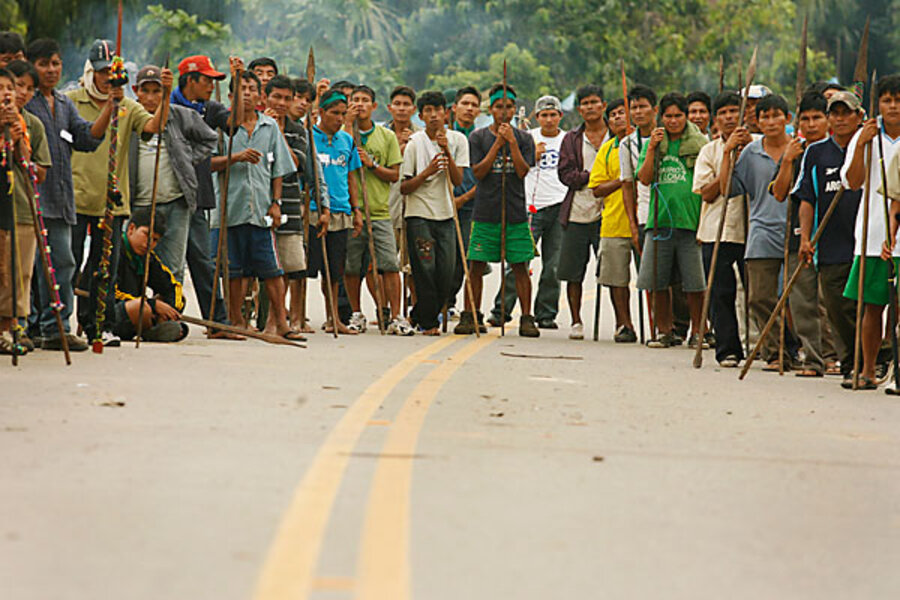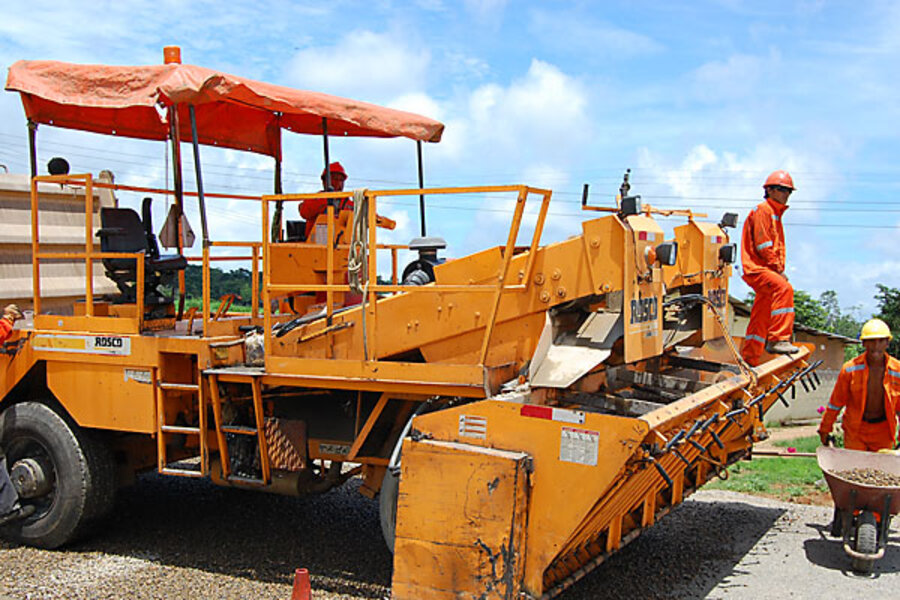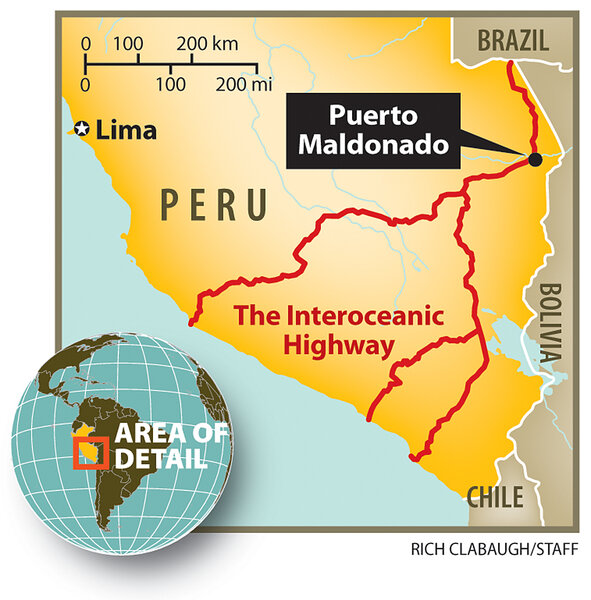Latin America's surprise rising economic star: Peru
Loading...
| Lima, Peru
Often overlooked as a player in the global economy, Peru is determined to prove that it’s more than just llamas, bowler hats, and Macchu Picchu.
And these days, the Andean nation has quite a case to make.
Its 9.8 percent growth rate last year was one of the world’s fastest. And record commodities prices, coupled with China’s insatiable demand for raw materials, are helping the mineral-rich nation weather the financial crisis better than most other countries in the region.
Now, Peru predicts that the construction of a new road between its Pacific coast and Brazil will replace the Panama Canal as the main passage for trade between rising superpower China and the agricultural juggernaut – adding a full percentage point to Peru’s gross domestic product. Add to that new oil and gas projects worth billions of dollars, and you’ve got a country poised for a giant leap.
Not since the height of the Spanish Empire, after Francisco Pizarro subdued Incan Emperor Atahualpa during his quest for the mythical golden city of El Dorado, has Peru been better positioned to play a key role on the world stage. But the country has long been dogged by a “resource curse” – vast reserves of gold, silver, tin, iron, zinc, and copper that have sparked more turmoil than development. Now the question is whether Peru – pound for pound, one of the world’s richest countries in terms of resources – can avoid repeating mistakes that have stunted its growth in the past.
The country has experienced decades of extreme left-wing and right-wing authoritarian governments and a brutal leftist insurgency waged by the Shining Path. But Peru’s past two pro-business, yet center-left governments have steered the country toward record economic growth, greater transparency, and rapid decentralization. The result: Peru has matured politically to the point where analysts – and investors – are beginning to talk about another regional powerhouse creeping up alongside Brazil.
“South America in general, and Peru in particular, are the region and country of the future,” says Francisco Sagasti, a senior associate at FORO, a development think tank based in Lima. “We’ve tried every macroeconomic model, and we’ve learned from our mistakes. No one is pushing for nationalization here. Everyone here knows that you have to have sensible economic policies from top to bottom.”
Indeed, Peruvians of all walks of life seem to agree that the country is not likely to follow its Andean neighbors Bolivia and Ecuador toward the “21st century socialism” of Venezuela’s Hugo Chávez. They’ve been there, done that. And, although President Alan Garcia’s approval rating now hovers near 30 percent, few quibble with the fact that Peru has enjoyed an average annual economic growth rate of 7 percent since 2003 or that per capita income has doubled and poverty plummeted from 50 percent to 35 percent in roughly the same time.
Peru’s ruling classes are almost giddy with excitement. “Latin America has the opportunity to be a major player like never before,” says former center-left President Alejandro Toledo, the country’s first indigenous leader and who is widely expected to be a top candidate again when Peru votes in a little over a year. “Peru is a hub for Pacific countries and China’s coming like a bulldozer.”
Barriers to a boom
But Peru’s rapid ascent is not a given. In some of its historically neglected mountain and jungle areas, social unrest lurks just beneath the surface, ready to thwart progress if people in those regions don’t feel more a part of the economic boom.
In June, clashes between indigenous protesters and armed forces killed more than 30 in the worst political violence since the Shining Path’s campaign of terror in the 1990s.
Native groups say the confrontation, which led to the resignation of Peru’s prime minister and the exile of a top indigenous leader, took place because the government refused to consult them before opening up their ancestral lands to oil and gas exploration.
Peru’s Congress quickly repealed two decrees by President Garcia that were aimed at opening wide swaths of the Peruvian Amazon to logging, dams, and oil drilling, and Garcia admitted that his failure to properly consult with indigenous groups on these matters was a mistake. Still, Garcia remains committed to the energy exploration that he and many others believe is crucial for the development of the nation. With half of the country identifying as indigenous, such conflicts are likely to come up again.
“Peru is very geographically fragmented,” says Mr. Toledo, explaining that Peru’s Andes are difficult to access and that two-thirds of the country is road-swallowing Amazonian jungle. “That’s its beauty, but also its challenge.”
The country is now in a race to spread decisionmaking power and largess from its recent boom to long-neglected rural areas.
“One of the weak points of [Peru’s economic] growth is that the interior of the country has been left behind,” says Epifanio Baca, the coordinator of the Citizen Watch Program, which has spent more than 20 years monitoring mining in Peru.
But that’s changing.
Mr. Baca says that one of the most important developments in the past few years is that the tax on mining has increased from 7 percent to 30 percent, and that half of that tax revenue is sent to Peru’s regional governments.
The fact that 15 percent of extractive industry earnings now goes to regional governments is hailed as Exhibit A in Peru’s aggressive moves to decentralize power away from Lima.
“Decentralization is vital, because [rural Peruvians] see effective governance and improvement of life at the national level – in Lima – but they don’t see it where they are,” says Vito Verna, who monitors social conflicts at the national ombudsman’s office.
Mr. Verna’s office, which was created earlier this year, keeps an eye on nearly 300 simmering local conflicts, almost half of which are related to mining, oil, or gas activities. The office plays the role of mediator in any conflict in which all the stakeholders have asked for dialogue.
“A year ago, only 25 percent of conflicts had dialogue. Now 50 percent have dialogue,” he says. “Peruvian society is evolving. Now, people who’ve historically been discriminated against are more a part of things.”
But as the central government devolves power from Lima, where one-third of the population lives, it’s finding that many regional governmental officials don’t have needed management skills.
“Competency training for regional officials is now vital,” says Verna’s boss and head of the ombudsman’s office, Eduardo Vega Luna.
And then there’s corruption. As regional budgets have exploded, so have the number of graft allegations against local and regional officials.
Still, by most accounts, there’s been tremendous progress on government accountability.
“Corruption affects all levels of government, but Peru has moved forward,” says Baca, of the Citizen Watch Program. “Any citizen can now see how money is being spent on a month-to-month basis.”
Peru is the only country in Latin America to sign on to the Extractive Industries Transparency Initiative (EITI), which was started in 2002 by former British Prime Minister Tony Blair to enable citizens to more closely monitor the flows of money from energy and mining companies to the host country’s local, regional, and federal government.
The goal of the initiative is to combat the government corruption that has plagued resource-rich countries, often leading to social unrest and deadly armed conflict.
Baca has been instrumental in coordinating efforts to independently audit willing oil, gas, and mining companies and ensure that payments by companies to the different branches of government – and revenues received by government – are widely publicized for any interested party to read.
A steep learning curve
Peru is nearing the end of the two-year process to become certified as completely EITI-compliant. It would be only the third such country.
The progress on transparency and accountability is “encouraging,” says Cynthia Sanborn, director of the research center at Pacific University in Lima. “There’s more learning from mistakes.”
But is Peru learning quickly enough?
During a visit to Peru earlier in December, Brazil’s president, Luiz Inácio Lula da Silva, signed 11 cooperation deals, mostly on trade and energy. Peru’s Garcia urged the scores of top-flight business leaders that accompanied Lula to invest his country.
“I’m deeply convinced that our peoples’ union and the road integration of our ports, flights, and trade will allow [us] to achieve both a very high level of well-being and [the] social justice we are all fighting for,” assured Garcia.
Coming months and years will reveal whether Peru’s political reforms will keep the “social justice” side of that equation on pace with its lightning-fast growth.
- Matthew Clark traveled to Peru on an International Reporting Project Gatekeepers trip.







